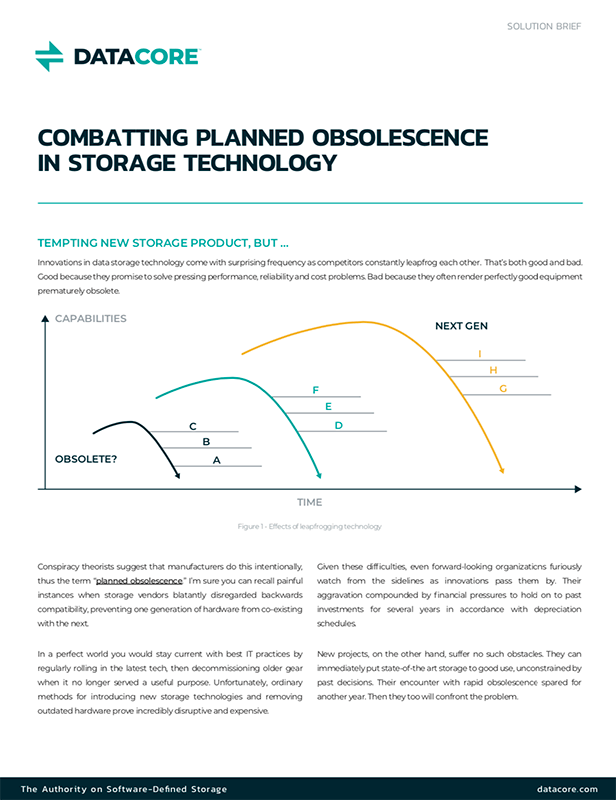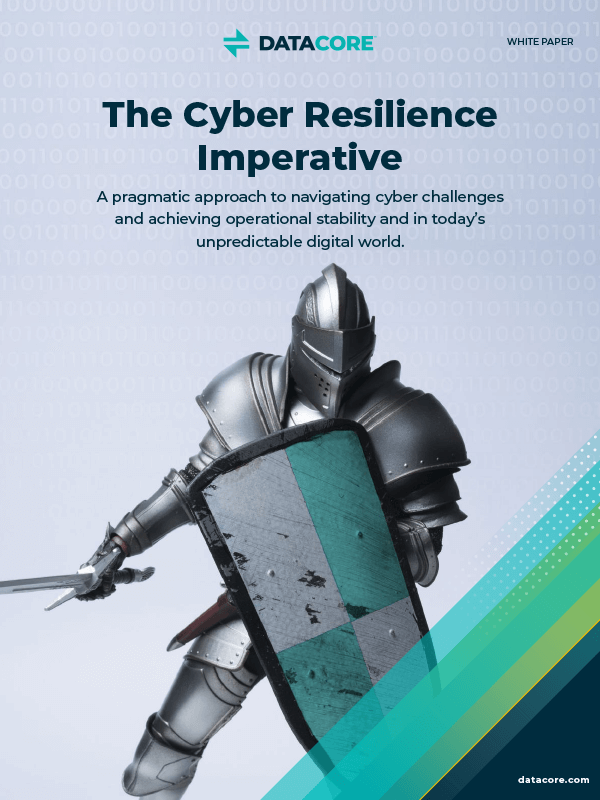Tempting New Storage Product, But...
Innovations in data storage technology come with surprising frequency as competitors constantly leapfrog each other. That’s both good and bad. Good because they promise to solve pressing performance, reliability and cost problems. Bad because they often render perfectly good equipment prematurely obsolete.
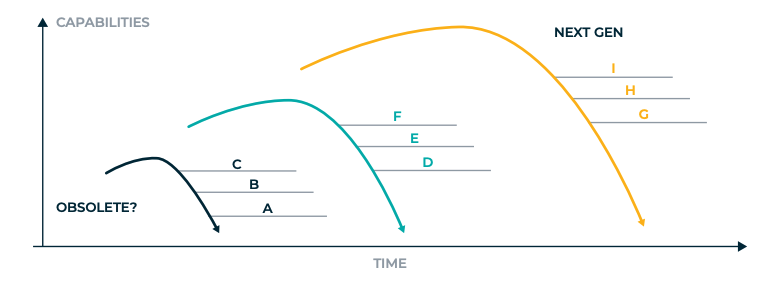
Conspiracy theorists suggest that manufacturers do this intentionally, thus the term “planned obsolescence.” I’m sure you can recall painful instances when storage vendors blatantly disregarded backwards compatibility, preventing one generation of hardware from co-existing with the next.
In a perfect world you would stay current with best IT practices by regularly rolling in the latest tech, then decommissioning older gear when it no longer served a useful purpose. Unfortunately, ordinary methods for introducing new storage technologies and removing outdated hardware prove incredibly disruptive and expensive.
Given these difficulties, even forward-looking organizations furiously watch from the sidelines as innovations pass them by. Their aggravation compounded by financial pressures to hold on to past investments for several years in accordance with depreciation schedules.
New projects, on the other hand, suffer no such obstacles. They can immediately put state-of-the art storage to good use, unconstrained by past decisions. Their encounter with rapid obsolescence spared for another year. Then they too will confront the problem.
Modernization Without Hesitation
We wouldn’t be dwelling on the sad, repeating cycle of obsolescence if we didn’t have a solution. One that lets you non-disruptively inject next-gen storage technology from competing suppliers, while extending the value from devices you already invested in.
Pick Best Storage Hardware for the Job
The answer comes in the form of an insulating layer of software enabling you to add, remove and even mix storage systems from different manufacturers without interruption, yet keep proven operating practices in place. It’s a special form of storage virtualization uniquely capable of hiding the physical and operational differences among storage systems, be they networked SAN arrays, direct-attached storage controllers, or in-server flash drives.
SANsymphony™ SDS platform, DataCore’s storage virtualization solution, includes a comprehensive set of advanced data services for the provisioning, protection and management of tiered storage resources located on-premises and in the cloud.
Essentially, the software cushions users, apps and system administrators from storage infrastructure improvements necessary for ongoing modernization and expansion. At the same time enhancing the value of current assets, thereby pleasing both you and your finance colleagues.
Storage consumers enjoy faster and more reliable data access for their most demanding workloads and lower cost when safeguarding historical data.
Adding Next-Generation Storage Effortlessly
To better appreciate the solution, let’s see how DataCore addresses the following factors that may be discouraging you from considering attractive storage innovations:
- Incompatibilities between new and existing operations
- Fear of potential outages during the conversion
- Risky and time-consuming data migrations
- Unwillingness to throw away recent investments now made obsolete
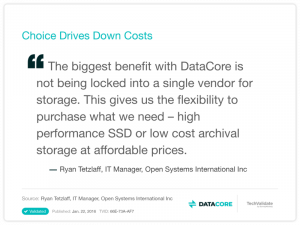
Leverage innovations undeterred by incompatibilities
Among the most distinguishing attributes of the DataCore solution is its dichotomy. It both pools mutually-incompatible storage resources so they can be uniformly managed, while segregating them into tiers where their unique properties are best applied.
Standardizing on a uniform set of data services in this way eliminates much of the costly transition and retraining upheaval we so despise. You’ll provision, protect and manage capacity from a new member in the storage pool the same way you’ll do it for your existing environment, employing common methods across different generations, models and brands of storage.
No downtime when switching
Those of you in charge of the infrastructure can look forward to adding, removing and upgrading equipment during normal working hours, absent the stress and downtime that generally accompanies many late nights and weekends in the trenches. The smooth changeover made possible even when the hardware being introduced is mutually incompatible and behaves quite differently from the existing subsystems.
In large part a higher degree of redundancy makes such non-disruptive activities feasible. Whereas in the past redundancy required like SAN arrays, DataCore software can combine unlike storage resources into a highly available storage infrastructure, synchronously mirroring data between them. At the same time, you gain an extra measure of protection against manufacturing/firmware flaws that would have taken down identical systems.
There’s also the inherit risk that the transfer becomes irreversible, and if it doesn’t work out you’re stuck. We’ve heard of numerous cases where organizations endure lengthy data migrations only to realize that the new gear isn’t making the difference they expected. The origin of deteriorating performance borne out of upstream bottlenecks discovered later. Of course, the money and time have already been wasted with nothing to show for it. In contrast, DataCore offloads data migrations from the hosts, putting additional compute, memory and I/O resources to work in the background. Migrations complete quickly and production workloads don’t suffer. Moreover, built-in instrumentation and analytics help isolate the root cause of poor storage performance before contemplating any drastic and potentially irrevocable actions.
Get better and longer use of perfectly good hardware
We don’t blame you for holding on to what’s working, especially if finance can continue depreciating the asset. Like many DataCore customers, you’ll find the software immediately closes many of the functionality and performance gaps you’ve been living with. The collective value you gain from this alone far outweighs the software investment.
You’ll also be glad to know that enhancements made to the DataCore data services apply to new and existing storage alike irrespective of their differences. This has two important benefits. The software innovations enhance the functionality of current hardware, mitigating the need to replace perfectly good gear with later models. And it extends the life of past hardware investments, so you won’t be in a rush for new equipment so frequently.
Fast, risk-free data migrations
If you’ve ever swapped out a large capacity storage array, you’ve likely experienced the agony of host-based data copying – methods that compete heavily with production workloads for resources. One of two complaints typically arise:
- The line of business folks can’t tolerate the application slowdowns, or
- Throttling back the copy rate to reduce contention prolongs the migration over several months
Rather than rip-and-replace storage, you’ll transition it through a thoughtful succession of roles, ensuring you realize the commodity’s full value throughout the depreciation period.
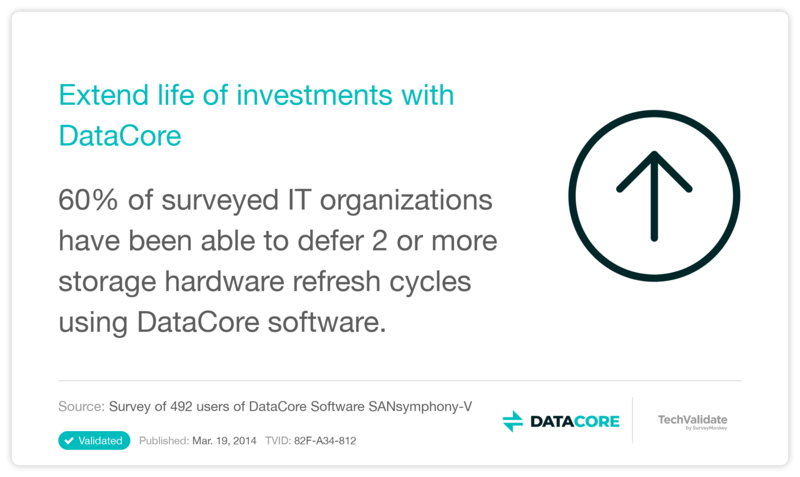
Bottom Line: Planned Obsolescence No Longer Obstructs Modernization
Armed with the DataCore solution, you can put aside concerns that new generations of storage technology will prematurely obsolete your current investments. Rather than fear such change, you will be in a position to aggressively pursue and benefit from modernization as urgency and budget dictate.
What to Do Next
Now that you have a better understanding on how to combat planned obsolescence, take the next step. Watch this webinar to learn more about the background, drivers and enablers to achieve IT modernization and flexibility within budget and without any disruption for your operations.
